
In Hinduism, Kundalini is a form of divine feminine energy believed to be located at the base of the spine, in the muladhara. It is an important concept in Śhaiva Tantra, where it is believed to be a force or power associated with the divine feminine or the formless aspect of the Goddess. This energy in the body, when cultivated and awakened through tantric practice, is believed to lead to spiritual liberation. Kuṇḍalinī is associated with Parvati or Adi Parashakti, the supreme being in Shaktism; and with the goddesses Bhairavi and Kubjika. The term, along with practices associated with it, was adopted into Hatha yoga in the 9th century. It has since then been adopted into other forms of Hinduism as well as modern spirituality and New age thought.

Kundalini yoga derives from kundalini, defined in tantra as energy that lies within the body, frequently at the navel or the base of the spine. In normative tantric systems, kundalini is considered to be dormant until it is activated and channeled upward through the central channel in a process of spiritual perfection. Other schools, such as Kashmir Shaivism, teach that there are multiple kundalini energies in different parts of the body which are active and do not require awakening. Kundalini is believed by adherents to be power associated with the divine feminine, Shakti. Kundalini yoga as a school of yoga is influenced by Shaktism and Tantra schools of Hinduism. It derives its name through a focus on awakening kundalini energy through regular practice of mantra, tantra, yantra, yoga, laya, haṭha, meditation, or even spontaneously (sahaja).

Swami Muktananda Paramahamsa, born Krishna Rai, was a yoga guru and the founder of Siddha Yoga. He was a disciple of Bhagavan Nityananda. He wrote books on the subjects of Kundalini Shakti, Vedanta, and Kashmir Shaivism, including a spiritual autobiography entitled The Play of Consciousness. In honorific style, he is often referred to as Swami Muktananda, or Baba Muktananda, or in a familiar way just Baba.
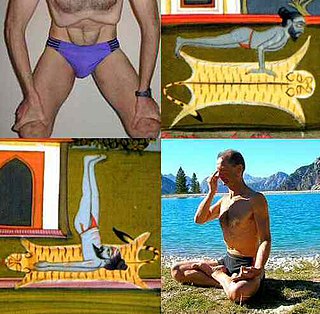
Hatha yoga is a branch of yoga that uses physical techniques to try to preserve and channel vital force or energy. The Sanskrit word हठ haṭha literally means "force", alluding to a system of physical techniques. Some hatha yoga style techniques can be traced back at least to the 1st-century CE, in texts such as the Hindu Sanskrit epics and Buddhism's Pali canon. The oldest dated text so far found to describe hatha yoga, the 11th-century Amṛtasiddhi, comes from a tantric Buddhist milieu. The oldest texts to use the terminology of hatha are also Vajrayana Buddhist. Hindu hatha yoga texts appear from the 11th century onward.
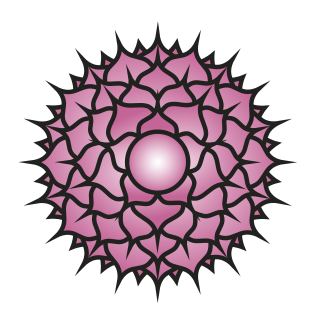
Sahasrara or the crown chakra is considered the seventh primary chakra in some yoga traditions. The chakra is violet in colour.
Sahaja Yoga is a religion founded in 1970 by Nirmala Srivastava (1923–2011). Nirmala Srivastava is known as Shri Mataji Nirmala Devi or simply as "Mother" by her followers, who are called Sahaja yogis.

Siddha Yoga is a spiritual path founded by Swami Muktananda (1908–1982). According to its literature, the Siddha Yoga tradition is "based mainly on eastern philosophies" and "draws many of its teachings from the Indian yogic texts of Vedanta and Kashmir Shaivism, the Bhagavad Gita and the poet-saints." The present head of Siddha Yoga is Gurumayi Chidvilasananda.

Sivananda Saraswati was a yoga guru, a Hindu spiritual teacher, and a proponent of Vedanta. Sivananda was born in Pattamadai, in the Tirunelveli district of Tamil Nadu, and was named Kuppuswami. He studied medicine and served in British Malaya as a physician for several years before taking up monasticism.
Shaktipata or Shaktipat refers in Hinduism to the transmission of spiritual energy upon one person by another or directly from the deity. Shaktipata can be transmitted with a sacred word or mantra, or by a look, thought or touch – the last usually to the ajna chakra or agya chakra or third eye of the recipient.

Satyananda Saraswati, was a Sanyasi, yoga teacher and guru in both his native India and the West. He was a student of Sivananda Saraswati, the founder of the Divine Life Society, and founded the Bihar School of Yoga in 1964. He wrote over 80 books, including the popular 1969 manual Asana Pranayama Mudra Bandha.
Gurumayi Chidvilasananda, born Malti Shetty on 24 June 1955, is the guru or spiritual head of the Siddha Yoga path, with ashrams in India at Ganeshpuri and the Western world, with the headquarters of the SYDA foundation in Fallsburg, New York.

Amrit Desai is a pioneer of yoga in the West, and one of the few remaining living yoga gurus who originally brought over the authentic teachings of yoga in the early 1960s. He is the creator of two brands of yoga, Kripalu Yoga and I AM Yoga, and is the founder of five yoga and health centers in the US. His yoga training programs have reached more than 40 countries worldwide and over 8,000 teachers have been certified.
Swami Vishnu Tirtha (1888–1969), also known as Munilal Swami, was a sanyas, writer, and guru with a prominent place in the Shaktipat tradition of Siddhayoga. He was born on 15 October 1888 in Jhajjar, Haryana, India. He stayed with an uncle while obtaining an undergraduate degree, then married and was employed as a teacher in Bilaspur, Chhattisgarh while he obtained a postgraduate degree and a baccalaureate in law from Aligarh Muslim University. He then practised as a lawyer in the Ghaziabad District of Meerut where his assistant was Late Chaudhary Charan Singh the former Prime Minister of India.
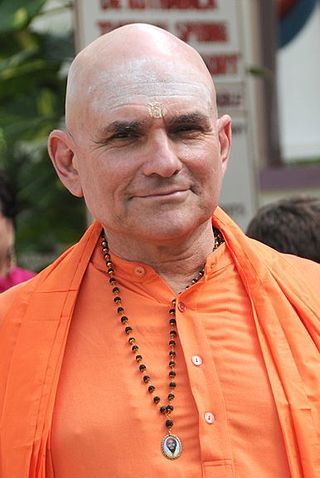
Mahamandaleshwar Swami Shankarananda is an American-born yoga guru in the lineage of Bhagavan Nityananda of Ganeshpuri. Swami Shankarananda is the author of several books on meditation and the philosophy and practice of Kashmir Shaivism. He emphasises spiritual practice (Sadhana), especially meditation, mantra and Self-inquiry. In Australia he founded a residential spiritual school in Australia, now called The Ashram Mount Eliza where about 20 seekers live and members of the wider public visit for programs, retreats and courses. Since 2015, there have been repeated allegations of coercive "secret sexual relations" between Shankarananda and women in the ashram community.

Mahamudra is a hatha yoga gesture (mudra) whose purpose is to improve control over the sexual potential. The sexual potential, associated with apana, is essential in the process of awakening of the dormant spiritual energy (Kundalini) and attaining of spiritual powers (siddhi).
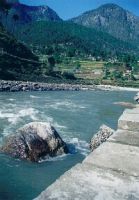
The Tirtha lineage of Siddhayoga is a mystical sect of Shaivite Hinduism. It believes in direct encounters with life-force or kundalini shakti, and understanding of the Shastras. It places importance on the guru-disciple bond, as, according to this tradition, the guru transfers shakti, the divine energy, to the disciple through a transformative process known as Shaktipat. Shakti is said to be automatically infused into a disciple by a guru in a process called Shaktipat.
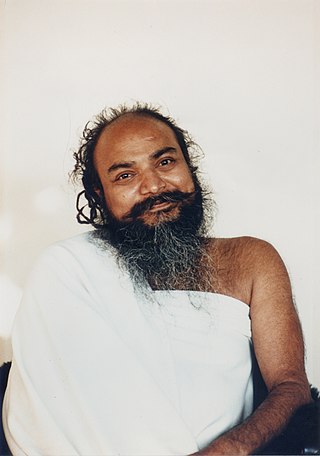
Shri Shivabalayogi Maharaj was a yogi who claimed to have attained self-realization through twelve years of arduous tapas, meditating in samādhi for an average of twenty hours a day.
Bhava Samadhi is a state of ecstatic consciousness that can sometimes be a seemingly spontaneous experience, but is recognized generally to be the culmination of long periods of devotional practices. It is believed by some groups to be evoked through the presence of "higher beings." "Bhava" means "feeling", "emotion", "mood", "mental attitude" or "devotional state of mind." "Samadhi" is a state of consciousness in which the mind becomes completely still and the consciousness of the experiencing subject becomes one with the experienced object. Thus, "bhava samadhi" denotes an advanced spiritual state in which the emotions of the mind are channelled into one-pointed concentration and the practitioner experiences devotional ecstasy. Bhava samadhi has been experienced by notable figures in Indian spiritual history, including Sri Ramakrishna Paramahamsa and some of his disciples, Chaitanya Mahaprabhu and his chief disciple Nityananda, Mirabai, Kundalini Guru Shri Anandi Ma, and numerous saints in the bhakti tradition.
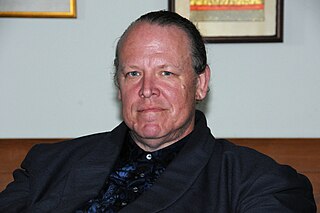
Mark Griffin was an American spiritual teacher in the lineage of Bhagawan Nityananda. Griffin was an author on the philosophy and practice of Yoga Tantra. He emphasizes spiritual practice (sadhana), especially meditation. He was the founder and director of Hard Light Center of Awakening, a Los Angeles-based spiritual school that, according to its literature, offers intensive training in meditation and other practical techniques of Enlightenment. He was also an artist.

The Yoga-kundalini Upanishad, also called Yogakundali Upanishad, is a minor Upanishad of Hinduism. The Sanskrit text is one of the 20 Yoga Upanishads and is one of 32 Upanishads attached to the Krishna Yajurveda. In the Muktika canon, narrated by Rama to Hanuman, it is listed at number 86 in the anthology of 108 Upanishads.















